Arthur the Arthropleura
Who is Arthur the Arthropleura?
Arthur is a model of the biggest invertebrate that has ever lived on land, a millipede-like creature called Arthropleura.
Where did Arthur the Arthropleura come from?
The model was originally on display in Kew Garden’s Evolution House but when the space was dismantled in preparation for the HLF funded restoration of the Temperate House, it was no longer needed and Kew kindly donated it to Amgueddfa Cymru – National Museum Wales.
The Arthropleura model was in need of some substantial conservation work when it arrived at Amgueddfa Cymru – National Museum Wales.
It had been on open display for many years in a glass house alongside living plants and was damaged and rusty.
The humid display environment had caused the surface paint to flake away and several spiders and snails had taken up residence on the underside of the model!
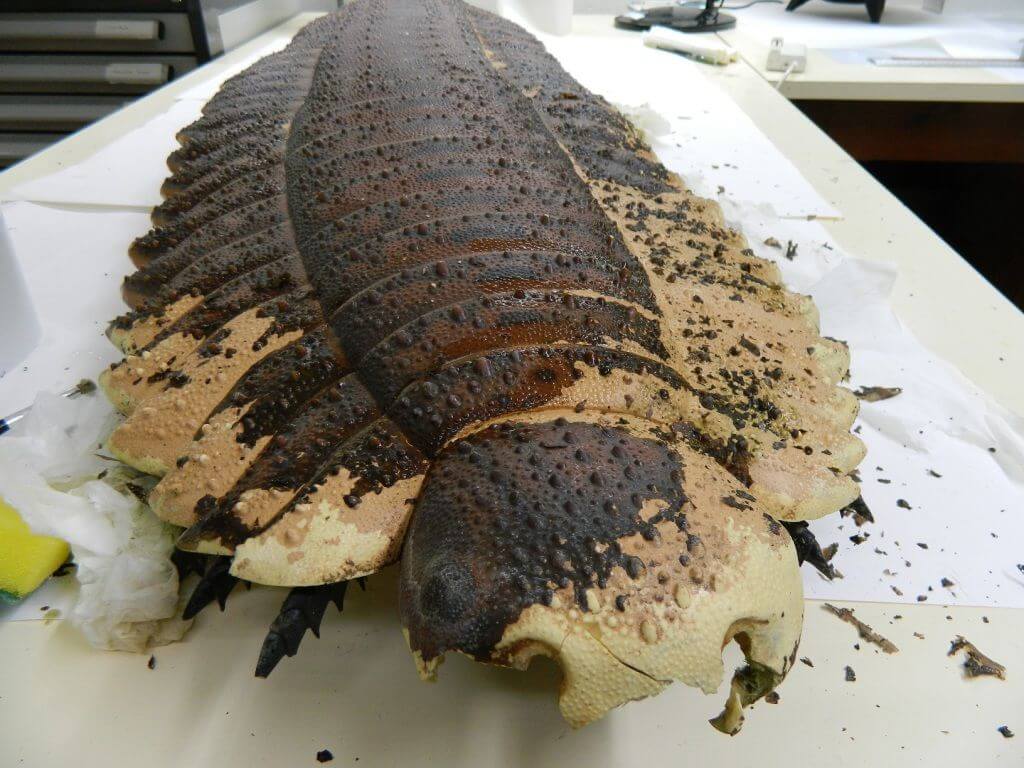
Arthur the Arthropleura before conservation
The first job was to give the model a good wash with hot soapy water and remove the dirt and cobwebs!
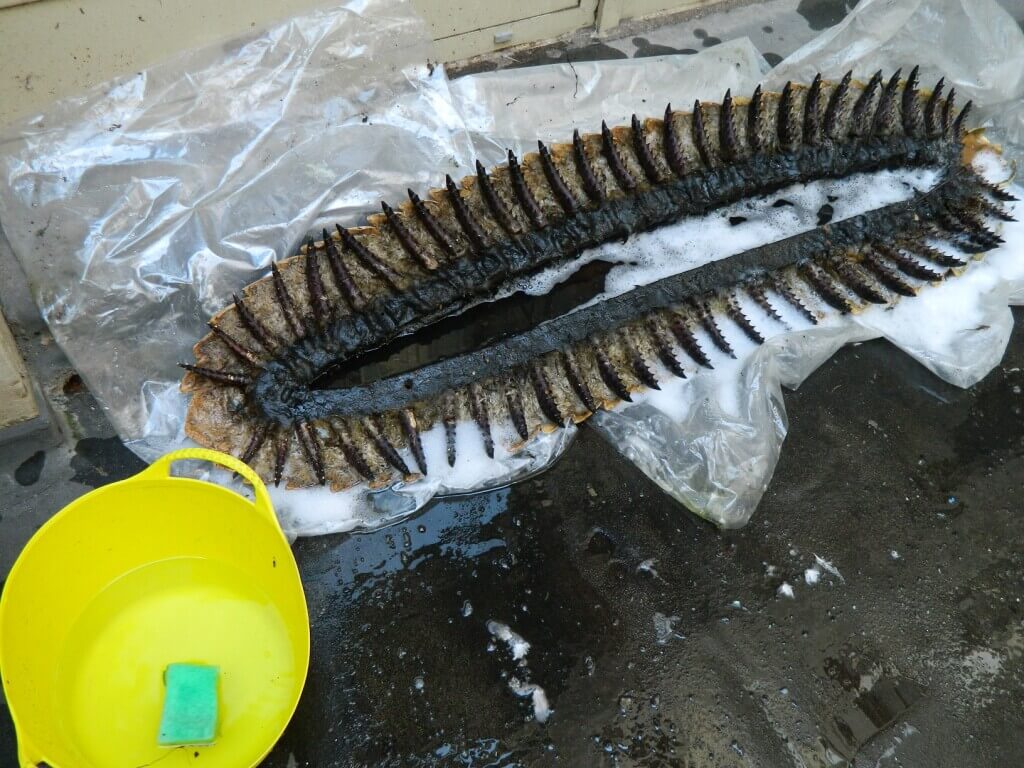
Arthur the Arthropleura has a bath
Then all the flaking paint was scrubbed off, the damaged areas on the legs and head were rebuilt with an epoxy putty and the surface textures recreated.
The nuts and bolts of the removable antennae had rusted together, so the metal parts were replaced with new stainless steel threaded rods.
Once the repairs were complete the model was carefully painted with acrylics and then coated in a durable varnish, making it once again suitable for public display.
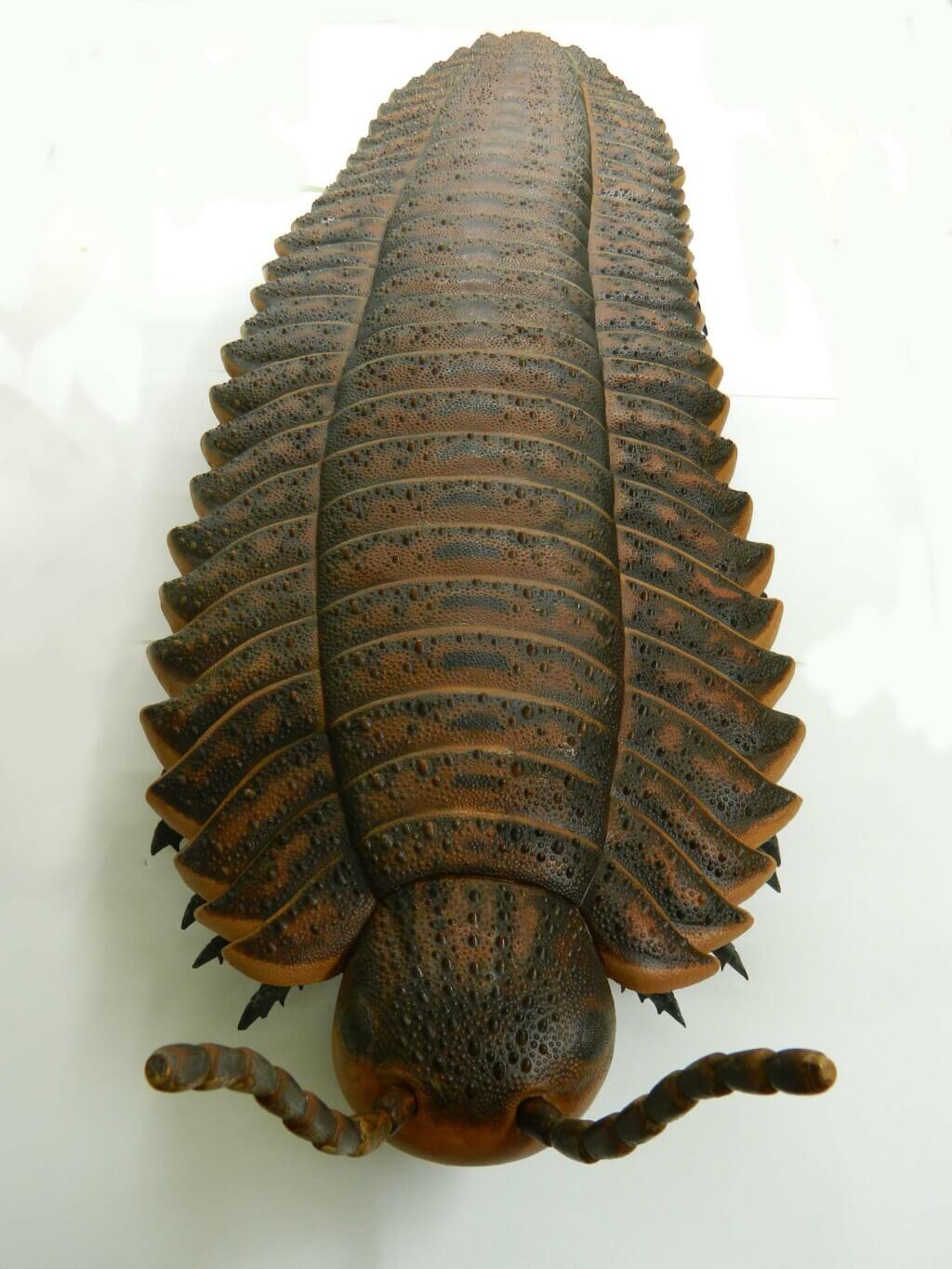
Arthur the Arthropleura after conservation
Who named the Arthropleura - Arthur?
Some of the Natural Sciences staff had become rather attached to the impressive 1.5m long millipede model whilst it underwent conservation work in the lab and named it Arthur the Arthropleura.
We have also had fun with Arthur; he has “escaped” and been on the run around the museum galleries!
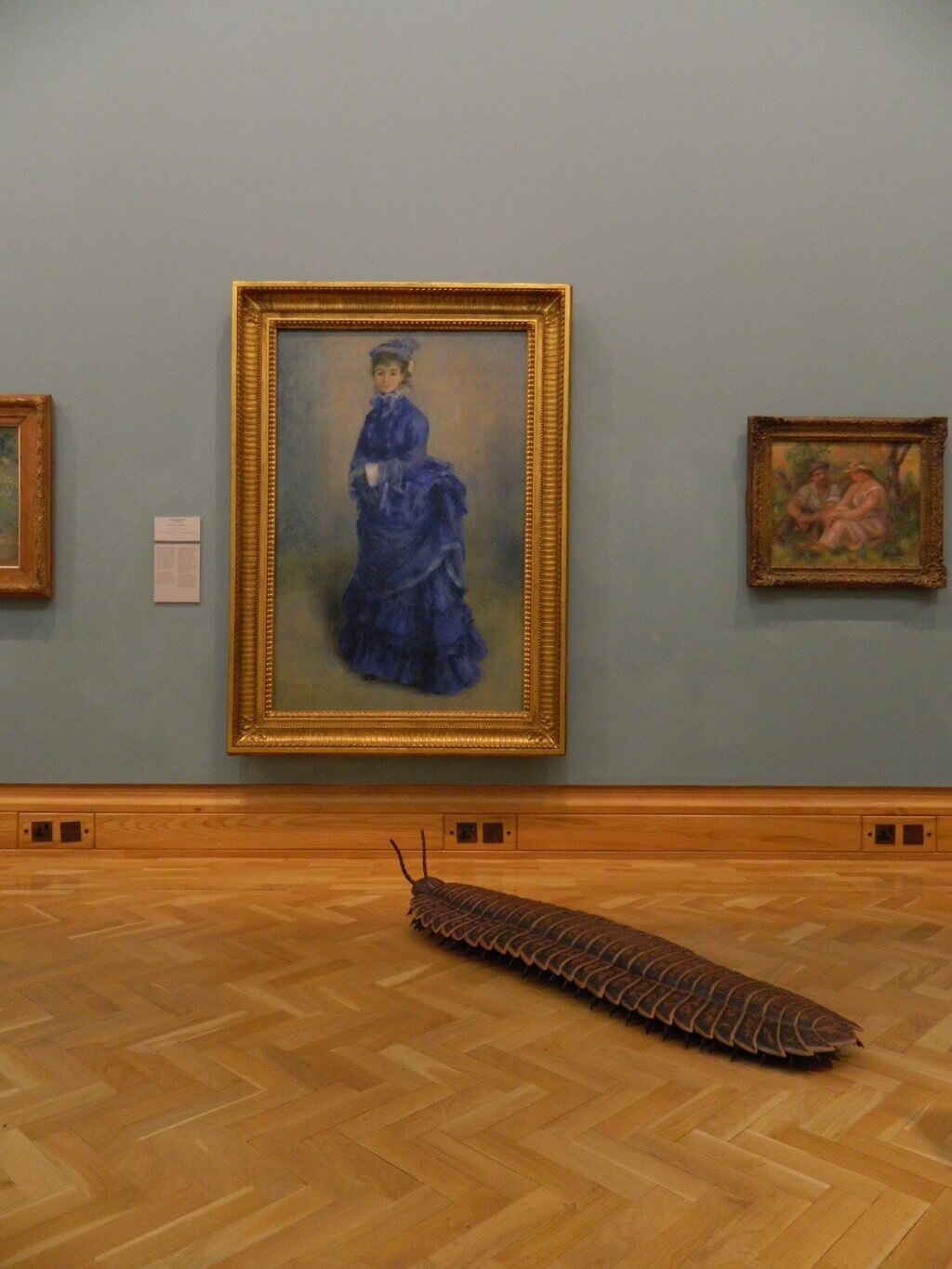
Arthur the Arthropleura visits the Impressionists
We posted pictures of his adventures on the @CardiffCurator Natural Sciences Twitter account and had a fantastic response from our followers.
Arthur the Arthropleura is now a social media star and is a really wonderful addition to our collections!
What did Arthropleura look like?
Arthropleura looked a lot like millipedes do today. It had a long, narrow body made up of lots of segments, and its back was covered in hard plates.
On the underside of the body, there were lots of pairs of jointed legs, around 8 pairs for every six body segments, which is similar to the number of legs modern millipedes have.
Recently, palaeontologists realised that what they had previously thought was the head of Arthropleura, is actually just the front segment of its body. The head was tucked underneath this segment, just like it is in millipedes today. So our model Arthur is a bit out-of-date, and he shouldn’t be looking straight ahead quite as much as he does.
How big was Arthropleura?
There are two types of evidence that tell us how big Arthropleura was. Fossils of the animal’s body, or parts of it, have been found in Germany, Belgium, France, the Czech Republic, and the U.K., but these are relatively rare. More common are fossils of the long trackways made by the many feet of the Arthropleura as it scuttled over damp ground. Its fossilised footprints are known from the USA, Canada, Germany, France and Scotland. Measuring the trackways tells us how wide the animals that made them must have been, and we can calculate from that how long the animals likely were.
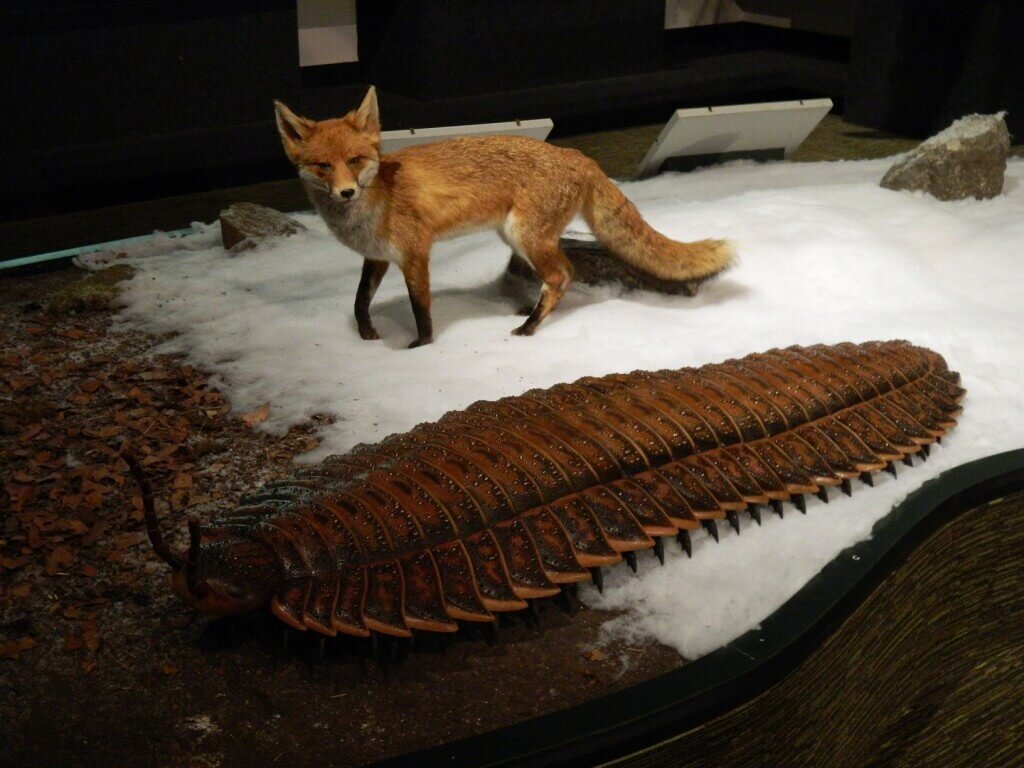
Arthur the Arthropleura next to a fox for size
Some places have several trackways in different sizes, showing that different sized (and probably aged) Arthropleuras were moving around in that area. The widest trackway known is 50cm wide, and the biggest Arthropleura is estimated to have been over 2m long.
Where did Arthropleura like to live?
Arthropleura fossils and trackways have been found in various locations that would have been fairly close to the equator 300 million years ago, including modern-day North America and the U.K.
Many of the first fossils were found in roof shales overlying coal seams, so it was thought for a long time that the giant creepy-crawlies just lived in humid coal swamps. Since then, evidence of Arthropleura has been found from a wider range of environments, including footprints walking along drier river banks.
It appears that they felt at home in a variety of landscapes with some vegetation cover.
Would Arthopleura have eaten me?
We can’t be certain what Arthropleura liked to eat, because its mouthparts have never been found in any fossils. However, if it did have tough, strong jaws for biting prey with, they would probably have survived and become fossilised. That may be circular reasoning, but there are other reasons why we think it probably ate plants rather than meat.
An Arthropleura fossil was found in Scotland in 1967, which had the remains of plants called giant clubmosses in the area where its gut would have been. It’s possible that the fossils were just preserved together by accident, so we can’t be certain the plants were actually Arthropleura’s last meal.
However, if its diet was similar to that of modern-day millipedes, it is likely to have lived on plant remains, seeds and spores.
Which other animals did Arthropleura share its home with?
If you looked around at the animals that shared Arthropleura’s world, you would see a very different view of life from today. There were no birds or mammals, because they hadn’t evolved yet. Scout around for our nearest relative, and you would eventually spy, lurking in the water, a large, squat amphibian called Eryops.
Animals with backbones were yet to gain a dominant foothold on dry land. Instead, creepy-crawlies accounted for most of the life you would have seen around you. There were large cockroaches (up to 9cm long) scuttling around, and spider-like creatures that would fill the palm of your hand. These weren't exactly like modern spiders - their fat bodies were divided up into segments rather than consisting of a single rounded piece, and they hadn't yet evolved the ability to spin webs - but they were well on their way to becoming the arachnids we see today.
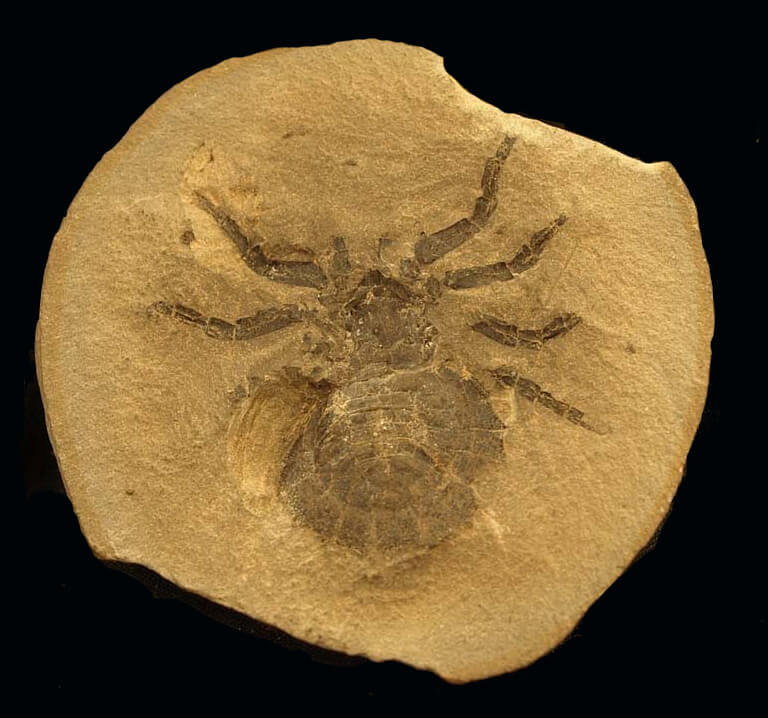
fossil of a primitive spider-like creature (Maiocercus celticus)
The air would have been filled with a distinct hum from the most awesome animals around – huge dragonfly-like insects called griffinflies, whose wingspans could exceed 70cm. Griffinflies were among the top predators of their day, and were some of the first creatures on Earth ever to fly, around 150 million years before the first birds took to the wing. Even our amphibian kin Eryops had to share its home with arthropods; horseshoe crabs that also liked to divide their time between dry land and water.
Why don’t we get such huge invertebrates on land today?
The Carboniferous Period, around 300 million years ago, was undoubtedly the era of huge invertebrates.
At that time, giant Arthopleura, the biggest creepy-crawly that has ever lived on land, was joined by large cockroaches, arachnids and dragonfly-like insects. How was that possible, and why don't we see invertebrates as big as Arthur today?
Our atmosphere has around 21% oxygen. The evidence suggests that 300 million years ago, oxygen levels approached 35%. That would have made a huge difference to the amount of energy that insects and other arthropods could generate.
Insects and millipedes don't have lungs to actively breathe in air like we do. Instead, their exoskeletons have lots of tiny tubes passing through them called spiracles. Oxygen diffuses in through the tubes from the outside into a blood-filled cavity, from where it gets distributed around the animal's body, fuelling everything it does. More oxygen available meant more fuel, which enabled creepy-crawlies to grow bigger, and which would have been especially important in generating enough energy to get large flying insects off the ground. Such giants could not get airborne under today's atmospheric conditions.
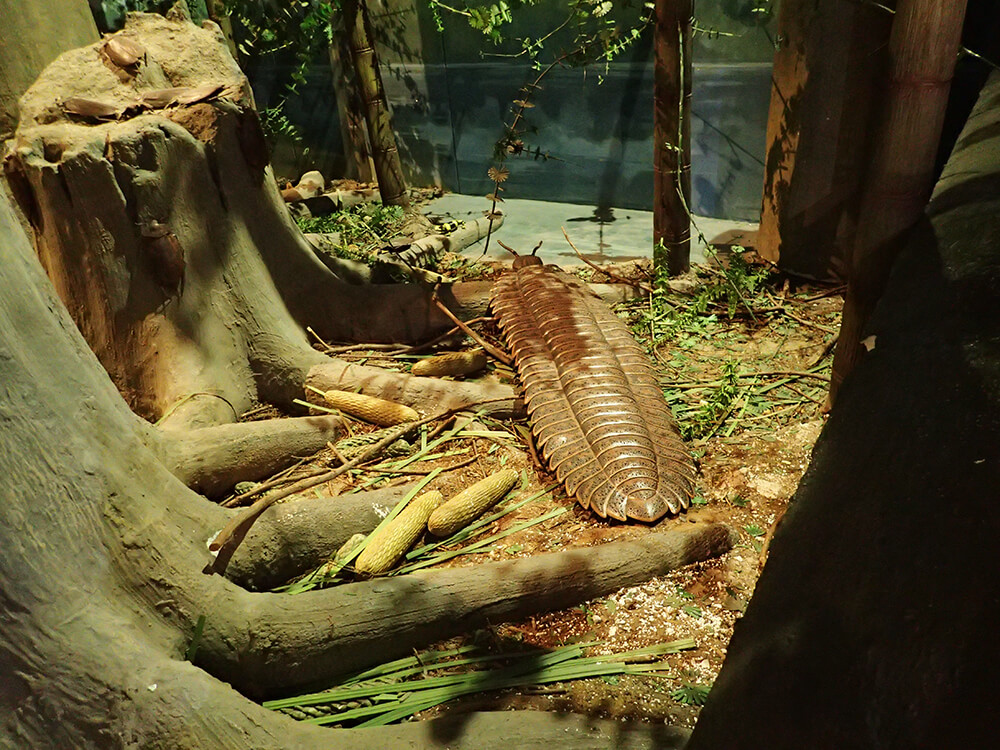
Arthur in one of his natural habitats, the coal swamp in our Evolution of Wales gallery
Oxygen levels aside, there are mechanical limitations to having an exoskeleton, which make it unlikely that such large invertebrates could exist today.
In order to grow bigger, all arthropods need to moult off their old exoskeleton and grow a new larger one. There is a period of time after moulting when the new exoskeleton is soft, and the arthropod must wait for it to harden before it can carry on with its normal life. Not only is this a dangerous time when the animal is vulnerable to predators, but it places a limit on size – if the exoskeleton becomes too big and heavy, it risks collapsing under its own weight.
That is one reason why the largest arthropods today live in the ocean, where the water helps to support their weight. There is also a limit on how big creepy-crawly legs can get, as the bigger they get, the thicker the cuticle they're made of becomes. They can only get to a certain size before the thick cuticle doesn't leave enough room inside for the muscles needed to operate the legs.
Another factor allowing Arthur and others to grow so huge may have been the lack of large vertebrate predators. For a variety of reasons, it just isn't possible for such giant creepy-crawlies to exist today.
Lucy McCobb, Caroline Buttler & Annette Townsend
Glossary:
Arthropod – an invertebrate animal with a hard exoskeleton and jointed limbs.
Invertebrate – an animal without a backbone.
Exoskeleton – a tough outer skin, which provides support and protection to animals without an internal skeleton.
Comments - (1)